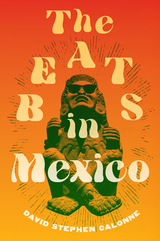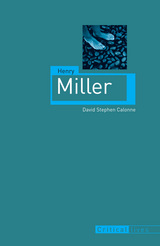2 books about Calonne, David Stephen

The Beats in Mexico
David Stephen Calonne
Rutgers University Press, 2022
Mexico features prominently in the literature and personal legends of the Beat writers, from its depiction as an extension of the American frontier in Jack Kerouac’s On the Road to its role as a refuge for writers with criminal pasts like William S. Burroughs. Yet the story of Beat literature and Mexico takes us beyond the movement’s superstars to consider the important roles played by lesser-known female Beat writers.
The first book-length study of why the Beats were so fascinated by Mexico and how they represented its culture in their work, this volume examines such canonical figures as Kerouac, Burroughs, Ginsberg, Lamantia, McClure, and Ferlinghetti. It also devotes individual chapters to women such as Margaret Randall, Bonnie Bremser, and Joanne Kyger, who each made Mexico a central setting of their work and interrogated the misogyny they encountered in both American and Mexican culture.
The Beats in Mexico not only considers individual Beat writers, but also places them within a larger history of countercultural figures, from D.H. Lawrence to Antonin Artaud to Jim Morrison, who mythologized Mexico as the land of the Aztecs and Maya, where shamanism and psychotropic drugs could take you on a trip far beyond the limits of the American imagination.
The first book-length study of why the Beats were so fascinated by Mexico and how they represented its culture in their work, this volume examines such canonical figures as Kerouac, Burroughs, Ginsberg, Lamantia, McClure, and Ferlinghetti. It also devotes individual chapters to women such as Margaret Randall, Bonnie Bremser, and Joanne Kyger, who each made Mexico a central setting of their work and interrogated the misogyny they encountered in both American and Mexican culture.
The Beats in Mexico not only considers individual Beat writers, but also places them within a larger history of countercultural figures, from D.H. Lawrence to Antonin Artaud to Jim Morrison, who mythologized Mexico as the land of the Aztecs and Maya, where shamanism and psychotropic drugs could take you on a trip far beyond the limits of the American imagination.
[more]

Henry Miller
David Stephen Calonne
Reaktion Books, 2014
As an author, Henry Miller (1891–1980) was infamous for his explicit descriptions of sex, and many of his novels, from The Tropic of Cancer to Black Spring, were banned in the United States on grounds of obscenity. But his books—frequently smuggled into his native country—became a major influence on the Beat Generation of American writers and would eventually lead to a groundbreaking series of obscenity trials that would change American laws on pornography in literary works. In this new critical biography, David Stephen Calonne goes beyond Miller’s notoriety to take an innovative look at the way in which the author’s writings and lifestyle were influenced by his spiritual quests.
Charting Miller’s cultivation of his esoteric ideas from boyhood and adolescence to later in his career, Calonne examines how Miller remained deeply engaged with a variety of philosophies, from astrology and Gnosticism to Eastern thinkers. Calonne describes not only the effects this had on Miller’s work, but also to his complex and volatile life—his marriages and love affairs with Beatrice Wickens, June Mansfield, and Anaïs Nin; his years in Paris; and the journey to Greece that resulted in the travelogue The Colossus of Maroussi, the book Miller considered to be his greatest work. After discussing Miller’s final residences in Big Sur and the Pacific Palisades in California, Calonne considers the author’s involvement in the arts, love of painting and music, and friendships with a number of classical musicians. Miller, Calonne reveals, was a quirky, charismatic man of genius who continues to influence popular culture today.
Highlighting many areas of the author’s life that have previously been neglected, Henry Miller takes a fascinating revisionary approach to the work of one of American’s most controversial and iconic writers.
Charting Miller’s cultivation of his esoteric ideas from boyhood and adolescence to later in his career, Calonne examines how Miller remained deeply engaged with a variety of philosophies, from astrology and Gnosticism to Eastern thinkers. Calonne describes not only the effects this had on Miller’s work, but also to his complex and volatile life—his marriages and love affairs with Beatrice Wickens, June Mansfield, and Anaïs Nin; his years in Paris; and the journey to Greece that resulted in the travelogue The Colossus of Maroussi, the book Miller considered to be his greatest work. After discussing Miller’s final residences in Big Sur and the Pacific Palisades in California, Calonne considers the author’s involvement in the arts, love of painting and music, and friendships with a number of classical musicians. Miller, Calonne reveals, was a quirky, charismatic man of genius who continues to influence popular culture today.
Highlighting many areas of the author’s life that have previously been neglected, Henry Miller takes a fascinating revisionary approach to the work of one of American’s most controversial and iconic writers.
[more]
READERS
Browse our collection.
PUBLISHERS
See BiblioVault's publisher services.
STUDENT SERVICES
Files for college accessibility offices.
UChicago Accessibility Resources
home | accessibility | search | about | contact us
BiblioVault ® 2001 - 2024
The University of Chicago Press









